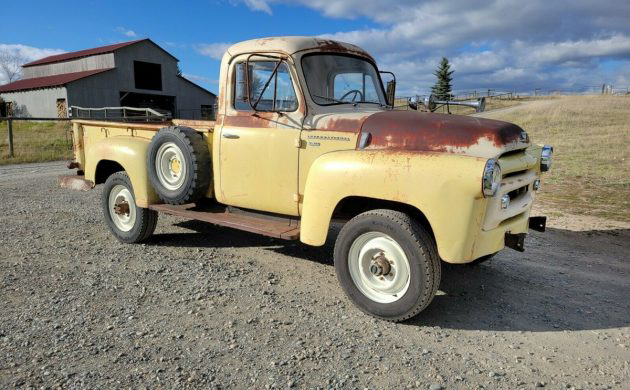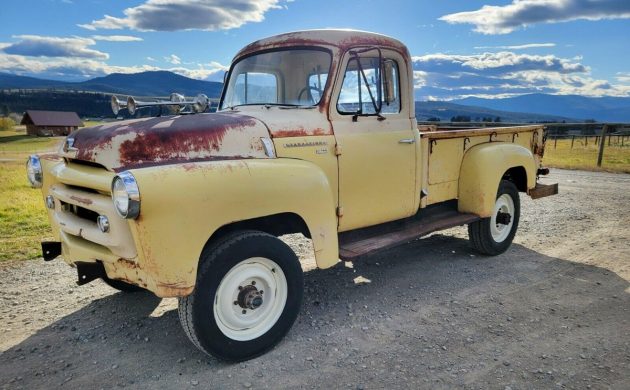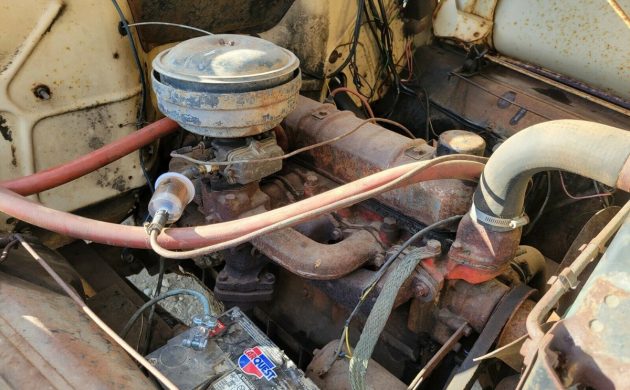There isn’t much plastic on this 1957 International S-120 4×4 stepside pickup, unlike new trucks. There are maybe a half-dozen plastic bits on the interior if even that. This is one tough truck. The seller is probably familiar to a lot of Barn Finds readers and they have this 4×4 listed here on eBay in Eureka, Montana. The current bid price is $6,150 but the reserve isn’t met.
I love the look of this paint even though I know that the patina vs. paint vote is probably the same as most elections: 50/50. Would I rather have it in like-new condition? Or course, but I wouldn’t mind it as it looks now. The S-series International trucks were introduced in the fall of 1955 and they came right after – are you sitting down? – the R-series! I know… Oddly enough, then the company went back to the A-series rather than the T-series. If anyone can make sense of vehicle naming conventions, old or new, let us know.
Actually, the following A-series was named for International’s 50th “A”nniversary of truck production, just for the record. This seller has offered a nice variety of rugged always fun-to-see pickups over the last few years. I wonder why we, and I say “we” as if we all might think alike on this, don’t mind a giant steel bumper like this on a pickup but “we” always make fun of a Pinto or Maverick or a car with a giant chrome or plastic-covered bumper? Weird.
Inside the truck bed is rusty as you’d expect it to be, but it doesn’t look like it’s in danger of caving in or being unrepairable. The interior was fairly nice for a pickup in 1957 but it’s getting a little rough now. That level of surface rust gives me the shivers, yet the bidders must see this truck as being repairable without too much trouble or expense to have bid it up as high as it is now. And, the seller must know what it’s worth if the reserve isn’t even met yet. Speaking of that, Hagerty is at $7,300 for a #4 fair condition truck.
The engine should be International’s “Black Diamond” BD-240, a 240 cubic-inch inline-six with around 130 horsepower. It runs good but needs to have the carb rebuilt and a few other things, but it’s a running and driving truck as it sits now. How would you restore this one? Nut-and-bolt back to like-new, or get it reliable and leak-free and drive it?






Great truck!
I keep waiting for my old ’66 IH step side/short box to show up on the site one day.
The animator had to be looking at this truck when he conceived “Mater” for Radiator Springs
I was looking for something just like this before I got my squarebody. I’d have to bring out the big guns, Geomechs, our foremost authority on IH, why there was no “T” series? It may have been “A”, for anniversary, or that the Travelall came out to avoid confusion, either way, it’s a rare horse. The “S” model ( not to be confused with a later class 8 “S” model) was the last of the “old style” IH trucks, and the “A” series was a whole new truck. Like all this stuff, horribly inadequate for today, a seemingly reoccurring theme, and while there’s technically nothing wrong with it’s mechanicals, just not up to par for today. These had tall gearing, like 5:38 something, and was made to pull stumps and farm wagons out of mudholes,( with THAT hitch) and such, I-70, not so much.An O/D would help some, if you dare to go 70 mph in this bucket of bolts, when 40 was it’s clear maximum safe speed. Be great for around the farm, but needs to be updated for any other purpose. Great find, no foolin’,,
It was merely a coincidence that the S-series followed the R-series. The series prior to the R-series was the L-series, and prior to that was the KB-series which was preceded by the K-series and before that the D-series. So there was no intention of alphabetical order. And it is correct that they went to the “A-series” designation for the new truck introduced in 1957 because it was the 5oth anniversary of International truck production. The A was followed by the B (1958-60) and then the C (1961-62), but then they changed the algorithm again and went from the C followed by a three-digit number to C followed by a four-digit number (1963-64) and then D (1965) and then changed again and went to a four digit number followed by a letter: xxxxA for 1966, xxxxB for ’67, xxxxC for ’68 and xxxxD for ’69–yet the ’69 was a totally different design. From ’70 on to the last of the light duties in ’75 there were still more changes to the way International designated their series, including going back to three digit numbers near the very end.
I grew up with Internationals. My dad was a masonry contractor and had a KB-6 dump truck, two ’54 R-100 pickups, a ’57 A-110 pickup, a ’64 C-1100 pickup and a ’66 1300A lowboy dump. I learned to drive on the ’64. Four on the floor. The transmission hump must have been a foot high and two feet wide!
There’s a lot of people ask me that on an almost daily basis. Some designations make sense while others give you the idea that the guys were drinking their own bath water. Why did the Ford Model A follow the Model T? It seemed like Binder followed the same pattern. During the 30s it had A, then B, then C, and D. Then it decided to go to K, then KB. L, R, S; then it had the R-series of heavy duty trucks that ran through the 50s and 60s. RC, SC, AC, BC, those all stood for the basic models using the “C” for Cab-over engine. The C-series came out again but Binder decided to shake things up with the Loadstar, Fleetstar, Cargostar, Transtar, eventually leading up to the Lonestar. I never tried to get into the designers’ heads; it was enough of a challenge just working on them…
Darned nice look corn binder! If this were to end up in my shop it would be all original as possible and put back to as new as possible!
Weird speedometer in the ebay pics, but 80-90 mph was pretty academic.
This old truck with the nice background scenery would make for a nice painting or picture for a antique car calander.
I bought a ‘57 S120 2wd pickup in the mid ‘80s for $100. It was a Grampa Truck-looked like new- but the grandson “changed the oil”- from dirty oil to no oil. Bought a used engine for $35 and swapped it out. Awesome old truck. Cruised happily at 50 mph.
You had to DRIVE rigs built back then. They were not unsafe per se’. If you climb in and think you’re going to just sit there until you arrive at your destination, YOU are unsafe.
Iam in Australia had one of these ASW 120 . W stood for 4WD . It was bought new by Dept of Lands . Still had tag on Keys tough old Truck . Side opening Bonnet from either side .
Went for $7100. Someone got a nice looking rig.
Thanks for the auction update, Old Fool! And I don’t mean that the way it sounded!…
I missed another one! Been extremely busy as of late and haven’t been able to get onto this page as often as I would like to. Anyway this was Binders first 3/4 ton 4×4. It did offer a 140 4×4 from the R through the B series which was somewhat heavier than the 120. Good trucks as long as you took it slow because they could be rough. My dad had an S-120 4×4 on the ranch but it spent half its time in the shop. Thinking that 4x4s were troublesome Dad traded the S for a B-120 2wd in ‘59. It turned out that it was also in the shop. Dad finally clued in that it was the ranch foreman that was causing the breakdowns. Ol’ Cactus could destroy anything that wasn’t covered with hair and had four hooves. I might add that the S-120 went to a ranch over by the Sweetgrass Hills where it still sees daily service…